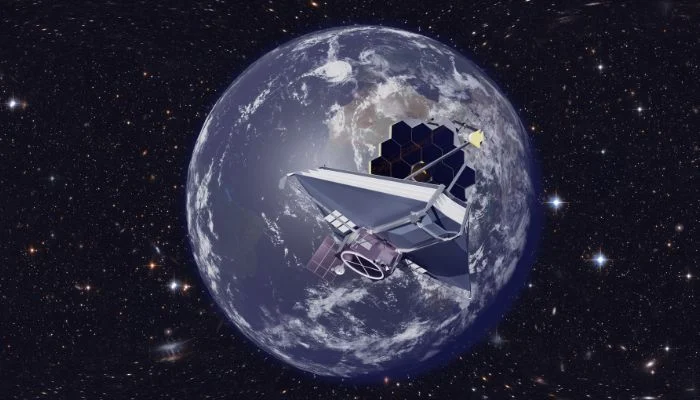Light travels at a finite speed of 280,000km per seconds – the speed of light. Because the speed is finite, every photon in every ray of light that reaches an eye or camera sensor left its source some time ago. If the object under observation is a few feet away, that time was a tiny fraction of a second ago. If the source is many trillions of kilometres away, the picture that is seen is quite literally of an object as it was billions of years ago. For that reason, it is said that telescopes are time machines.
Last week, the world got its first peek of images captured by the James Webb Space Telescope (JWST), developed over a period of 10 years, launched in December of last year and currently parked more than a million kilometres beyond the orbit of the Moon. Telescopes are also differentiated by the wavelength of the photons of ‘light’ (electromagnetic radiation) they are capable of detecting. The JWST is able to capture visible light and, more critically, improves on the ability to capture infrared light of its older cousin, the Hubble Space Telescope.
Since the beginning of the universe around 13.8 billion years ago, space has been expanding. One effect of that is that the wavelength of light in the visible spectrum emitted by sources in the early universe has been gradually increasing. That light from the earliest of objects in the universe is now in the infrared spectrum, the same kind used by your TV’s remote control. Due to its wider range in the infrared spectrum, the JWST will be able to capture those early photons, which makes it a time machine that will allow us to peer back as much as just 100-250 million years after the Big Bang.
If you think this will give us the earliest picture of the universe yet you are mistaken. That distinction goes to the picture of the Cosmic Microwave Background radiation released in 2012. It goes back to just 380,000 years after the Big Bang, a time when all matter in the universe was so densely packed together that stars, planets and galaxies could not form yet.
The price tag of the JWST has been $10 billion over 10 years, split between the lead partner of the project, NASA, and its European and Canadian counterparts, ESA and CSA.
As many economies around the globe are anticipating entering recessions, some people across the political spectrum are questioning the wisdom in spending this much money on space exploration. To put it in a local perspective, $10 billion over 10 years is comparable (but not equal) to Pakistan’s import bill of tea over the same period. The argument to postpone spending on science because there are more urgent needs at home is a weak one. Such a standard for spending on science and R&D would put all human exploration in the back seat permanently because there will always be competing priorities, and without exploration humans would still be living in caves.
Spending on science is a lot like spending on art. The Covid lockdowns in 2020 drastically curtailed options for activities, which meant that a lot more people were consuming artistic works (film, TV, music, books, games) and which hopefully made everyone appreciate the importance of the artist in society. Perhaps that is something science and art spending have in common – you only realize you need it when you do not have it.
I learnt most of this from following news coverage of the JWST since its launch late last year. In that period, not to my surprise, the contribution of local news sources to my education has been non-existent. Locally, hobbyist astronomer societies in major cities (Islamabad, Lahore, Karachi) organize meetups and viewings for the public around events on the astronomical calendar. Beyond that, however, in the broader media landscape of radio and television, there are few takers for in-depth coverage of this kind of news or science news in general outside the obligatory 30-second bulletin.
But the blame for this cannot be put on the supply side of information alone. For a look at the demand side (media consumers) consider the daily landscape of Pakistani/ Urdu social media which is a barren wasteland almost completely devoid of art, science, and exploration – anything that is not power politics or religion. Follow Pakistani Twitter for a few months and you could be forgiven for believing that the first thought on waking and last thought before sleeping of foreign leaders everywhere is Pakistan, that the world, nay the galaxy, revolves around us. Scroll your newsfeed back by six months, a year, even five years, and the only difference between the conversations you will see will be the cute nicknames the public and the media give political and corruption scandals of the day.
If you doubt that we have an inflated sense of self, may I remind you that just a few days ago our former prime minister declared that angels would hold voters that did not cast their ballot for the PTI accountable in their graves for not supporting him.
There are many good reasons to fund science and exploration and make it figure more prominently in everyday life. They include the economic argument of producing unforeseen yet commercially valuable inventions. Space exploration in particular has the ability to puncture our egos by showing us the relative insignificance of our size (and our problems) relative to the rest of the universe.
A population as science illiterate as ours becomes a target begging to be cheated by any charlatan that comes along. In 2012, Agha Waqar earned himself his own Wikipedia page as well as a spot on its page for “water-fuelled car” by claiming to have built a perpetual motion machine, something I wrote about in an article (‘Charlatans in a science illiterate society, Oct 2, 2016, The News on Sunday). Unable to figure out the impossibility of such a claim, the majority of people were willing to give Agha Waqar’s claims the benefit of the doubt. That was not surprising. However, what was shocking was that in the days to follow he was granted audiences with the country’s leading scientists and engineers, with the media in tow, and none was willing or able to call out the absurdity of his claim (save for one!).
On Oct 21, 2021 the New Yorker published an article titled ‘NASA’s New Telescope Will Show Us the Infancy of the Universe’. It retells an anecdote of Columbia University astronomer David Helfand from the ‘60s back when he was an undergraduate student. A professor asked him how he would justify spending on space exploration in front of Congress. He invoked the economic argument for his answer to which his professor replied it was the wrong answer. He said that the study of the universe is “like opera, or poetry” because exploration is “what distinguishes us as humans.” And so, while there are many valid reasons to explore the world we live in (economic, the ability to not be taken in by frauds), the best one is satisfying our human curiosity.
The writer (she/her) is a professional engineer and has a PhD in Education


 Latest News5 hours ago
Latest News5 hours ago
 Latest News5 hours ago
Latest News5 hours ago
 Latest News4 hours ago
Latest News4 hours ago
 Latest News5 hours ago
Latest News5 hours ago
 Business5 hours ago
Business5 hours ago
 Latest News4 hours ago
Latest News4 hours ago
 Business5 hours ago
Business5 hours ago
 Latest News5 hours ago
Latest News5 hours ago






















